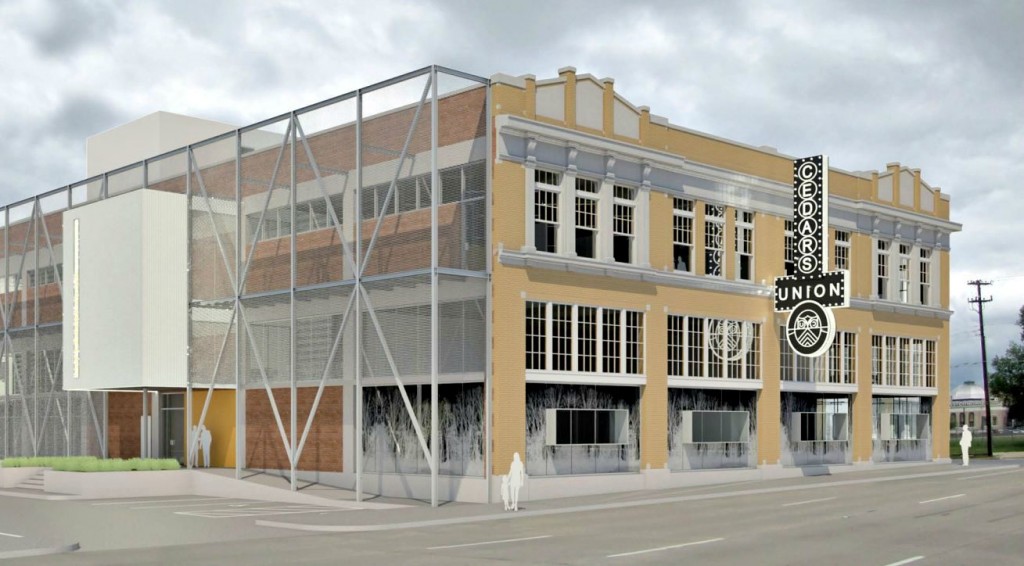A former ice cream plant in the Cedars area south of downtown Dallas will become a new home for the arts. But a different one. Cedars Union, as it’s called, will be like a private gym – with 24-hour access for artists to use fully-equipped workspaces. Or rent micro-studios. KERA’s Jerome Weeks says, the plan is for an ‘arts incubator.’
We’re in the old Boedeker ice cream plant, on Ervay just across I-30 from Dallas City Hall. Built in 1921, three-stories tall, yellow-brick and concrete, almost 40,000 square feet. This cavernous, dark, dusty space on the first floor was the ‘cold dock,” the refrigerated loading dock for trucks to fill up with ice, ice cream, dairy products. Old, large, wall-mounted fans are running, but the stifling heat in the room makes the air feel almost solid.
“And it’s very raw,” says Ben Griffith about the space, pointing at the fat concrete pillars. “I mean, you can tell paint-peeling. This is some of the old insulation that actually dates back to the ‘20s.”
Griffith is program manager for what’s called Cedars Union. This huge room will be used by artists working on larger-scale projects, like building theater sets. “And on this side here,” Griffith says, indicating the west wall, where a more recent, pre-fab metal warehouse has been attached, “we’re going to add an annex that will house our dirtier shops, our full wood-working, our full metal-working and we hope to include glass and ceramics in there as well.”
Communal workspaces like this — equipped with tools open anytime to dues-paying members — are hardly a new idea. In Carrolton, Dallas Makerspace provides classes and equipment for blacksmiths, welders, even engineers working in 3D design. But this is new to North Texas artists – on this scale, near downtown. And there’s more — like lecture halls and a coffee shop.
“Would you like to ride a creepy elevator?” Griffith asks eagerly. Why, sure. “It’s dangerous.” It’ll be the height of the tour, then. It’s one of those ancient freight elevators with a wooden safety gate you haul up and down, clattering and banging, the wood barely holding together.
The second floor of the Cedars Union is currently full of small, shabby offices — much more recently installed. These will be ripped out and replaced by some seventy micro-studios for lease, each around fifty-to-seventy square feet, plus a couple of larger spaces. The plans aren’t etched in stone yet, so there’s still wiggle room on the demand side, what can fit.
And then there’s the third floor with its oddly tiled walls. “We do know this was their mixing room. So this was another cold area in the building — although it’s not now,” Griffith adds. “It’s probably 114 degrees up here.”
On the top level is where there’ll be live-work spaces for three artists-in-residence. Griffith says the whole idea behind Cedars Union is to create an environment that’ll help emerging artists get from sketchy ideas to becoming full-fledged producers, to foster collaborations among different artists, even provide them with some entrepreneurial business guidance. The Bowdon Family Foundation bought the building late last year. But Griffith says Ken Bowdon first told him about creating what he calls an ‘arts incubator’ four years ago.

The ‘cold dock.’ Through the doorway is the pre-fab warehouse that’ll be torn down for the new workshop annex. Photo: Jerome Weeks
“And I said, ‘Well, it’s not going to work.’ And he said, ‘Why not?’ And I said, ‘Because you’d have to give this resource to the creatives to do with it what they want. You can’t dictate the process, they have to be a part of the process.’ And then, four years later, I’m eating crow because that’s exactly what he did. He and the Bowdon Family Foundation gave this to the community. So it’s exciting.”
Hundreds of local artists have been surveyed for what they really need. There are no galleries in the Union, for instance. It’s all about spaces and tools for working.
And on Tuesday, dozens of local artists toured the building, had lunch and were briefed on the plans and progress. Janielle Kaster, an actor-performer with the experimental cabaret group called The Tribe, was one. She was interested in seeing if their were any performance possibilities — even site-specific ones — whether there could be collaborations with visual artists. And she wanted to check out the Cedars.
“Dallas right now is like five decisions away from actually becoming a hub where we create new work and incubate new work. So it’s a pivotal time, and it’s really exciting that people like Cedars Union are making decisions toward the positive.”
Three blocks down Ervay Street from the Cedars Union is where the MAC, the McKinney Avenue Contemporary, will be moving over the next few years — with its mix of performance spaces and galleries. So the Cedars is becoming very much like West Dallas. Even as massive new apartment developments transform the area, artists continue to filter in, hunting for the affordable, the near-downtownable — while they still can — and in piecemeal fashion put to use a neighborhood much of Dallas wrote off or left decades ago.
Projected opening date for the Cedars Union: early 2017.






0 Comments